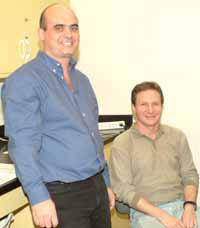New State-of-the-Art EEG System Will Enhance
Students and researchers in the Department of Biobehavioral Sciences can start to plan new types of studies soon, once a new high-density electroencephalographic (EEG) system arrives. The EEG system uses up to 256 scalp electrodes to study the time-course and localization of neural activity associated cognitive function. In other words, through the use of this equipment, not only will researchers be able to measure brain activity, but will also be able to do mathematical calculations to determine from where in the brain the activity is coming.
Through the support of a grant from the National Science Foundation (NSF), and the efforts of Professors Andrew Gordon and Peter Gordon and their colleagues at TC, the current research facilities in the movement science and speech science laboratories in Thorndike Hall and the basement of Thompson Hall will now contain the new state-of-the-art equipment to enhance the various kinds of research that can be done.
Funds were also requested to purchase a remote eyetracker that will be used to determine where subjects, including young infants, are looking when they are performing various tasks. The remote eye tracker they chose is different from other trackers that require cameras to follow a subject's eye gaze. According to Peter Gordon, this particular eye tracker builds a 3-D model of the subject's head using a few reference points. Once the coordinates have been registered, the subject can move up to 180 degrees and retain gaze direction or move out of the scene completely and coordinates will be reacquired immediately when they return into view. "This is particularly useful when testing young infants or active juveniles who are not particularly good at keeping their heads still," Peter Gordon said.
"Basically, Peter Gordon and I recruited a number of other faculty from TC to write a proposal that would involve the use of a core set of instrumentation or equipment with the central focus of the project being on the study of the integration of language and movement processes," said Andrew Gordon. "For example, my work will focus on studying typing and sign language skills and the movements involved with the hand during those skills."
Not much is known about coordination of eye and hand motion during typing, Andrew Gordon explained. Results of studies that have been done on eye-hand coordination during typing suggests that there is a unidirectional relationship-the success of hand movement planning and execution controls a large proportion of eye movements. The relationship between eye location and pressing a key is variable, and cannot directly trigger subsequent eye movements. What, then, determines the size of the eye-hand span? Does the position of the eye trigger finger movement or vice versa? Those are just a few of the questions Andrew Gordon and his students and postdoctoral fellows hope to answer with the new equipment.
Peter Gordon will be looking at whether infants understand the relevance of objects in the structure of events. He plans to use the EEG system to examine the kinds of brain activity that happens when changes are made that affect objects within event structures.
Other faculty members who contributed to the proposal include Professor Steven Lepore, who will be examining the role of written and verbal emotional expression on adaptation to life stressors. He will be using the EEG to measure brain activity during these behaviors.
Professor Robert Kretschmer will be using the eye-tracker to study the patterns of eye movements of emergent silent readers as well as to explore the relationship between eye movements and the ability of proficient readers to immerse themselves in a story world involving inference processes. These studies will shed light on reading strategies and the abilities of emerging readers.
Professor ZhaoHong Han plans to use the new equipment to develop empirical research approaches to how the brain functions during the process of second language acquisition in children and adults.
Assistant Professor Karen Froud will be using the EEG equipment to understand how language is processed in schizophrenics and other populations with language disorders.
The equipment will also be available to others in the College whose research may be enhanced by these types of measurements. "So long as the research focuses on the integration of language and movement processes and can utilize the type of equipment that we have, we welcome ideas for collaboration on utilization by faculty and the students that they are working with," Andrew Gordon said. "Certainly students who are working with faculty will be eligible to use this equipment."
He added, "For education, it's becoming increasingly important to understand the brain processes underlying verbal cognitive and movement processes, and the acquisition of this equipment is going to allow us to really explore some of these issues that have never been done before. I don't think that there are any other laboratories in the world that will have this capability of integrating this type of equipment together. I'm really excited about it."Published Friday, Dec. 19, 2003
